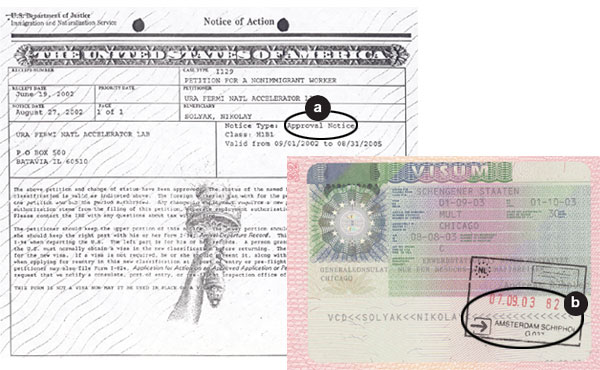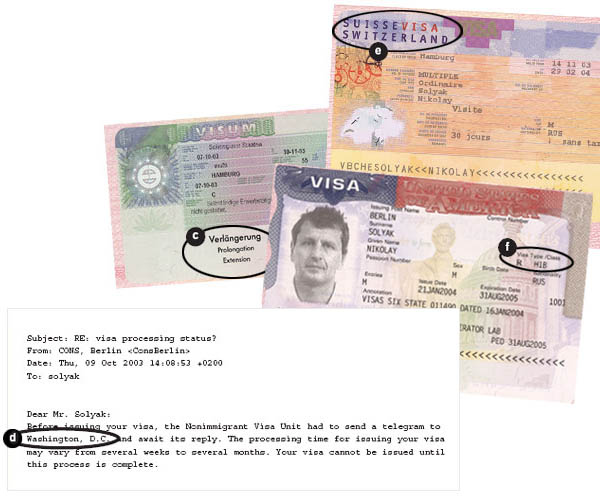Deconstruction: Visa quest
Russian physicist Nikolay Solyak is an expert on particle accelerators and helps to develop superconducting technology for a future International Linear Collider. He has been a Fermilab employee since 1999. When he left the United States in September 2003, a short trip abroad turned into a four-month odyssey, separating him from his work and family in the United States. His documents tell the story.

a |
August 27, 2002: The US Immigration and Naturalization Services notifies Fermilab of the approval of an H1-B status for Nikolay Solyak. The approval notice allows Solyak to continue working at Fermilab. The new status is valid for three years, the maximum duration. Should he or his family choose to travel outside the United States, they must obtain visas at a US embassy or consulate to return. In June 2003, Solyak's wife and 16-year-old son travel to Russia to visit relatives. Six weeks later they return with their new H4 visas. Solyak himself, who had to work over the summer, plans to get his new visa on an international business trip in the fall of 2003. |
b |
September 7, 2003: Solyak travels via Amsterdam to Hamburg to attend a scientific meeting and to collaborate with researchers at the German particle physics laboratory DESY. He expects his one-month stay in Germany to be sufficient to obtain an H1-B visa. Solyak's family stays in the United States, with his son attending classes at a high school. September 12, 2003: Solyak takes his passport and visa application, the H1-B status approval notice, and other documents to the Consular section of the US embassy in Berlin. The Visa Unit accepts Solyak's application but rejects hard copies of his curriculum vitae and his list of scientific publications. Fortunately, Solyak has computer access upon his return to Hamburg, and he produces and submits electronically the required plain text files the next day. He expects to obtain the visa in a couple of weeks. September 25, 2003: Two weeks after presenting all his documents at the embassy, Solyak receives an email asking him for additional information, such as "Flight plans to and from the US" and "Are you a resident of Germany?" He immediately submits the information, all of which he was prepared to provide at his visit of the embassy in Berlin. |

c |
October 1, 2003: Solyak calls the US embassy in Berlin at its toll-charged "900" number, paying close to $2 per minute, to ask for weekly updates on his visa application. He's told that his documents had been sent to Washington for clearance. With his German visa about to expire, Solyak makes arrangements with Fermilab and DESY to continue his research visit at the German lab. He applies for, and is granted, an extension of his German visa. |
d |
October 9, 2003: The US Embassy in Berlin replies to an email inquiry by Solyak: "Before issuing your visa, the Nonimmigrant Visa Unit had to send a telegram to Washington, D.C. and await its reply." Fermilab's Director, Michael Witherell, sends a letter to the US Embassy in Berlin: "Fermilab is home to scientists and other experts from more than 20 countries, and does not perform any classified work.... [The presence of Dr. Solyak is needed] to help fulfill the mission of this national laboratory." During the next three months, Solyak and Fermilab administrators inform the US Department of State, the US Department of Energy, US Representative Dennis Hastert, the National Academies, and other institutions in Washington, D.C. |
e |
November 30, 2003: Solyak's visa extension for Germany is about to expire and he has to leave the country. Unable to return to the United States without an H1-B visa, he contacts scientists at the European laboratory CERN and makes arrangements to visit them in Geneva, Switzerland, for two weeks. On December 5, he obtains a new visa at the German Consulate in Geneva and returns to Hamburg. December 23, 2004: Still without news from the US Embassy, Solyak realizes he won't be able to spend Christmas with his family in the United States. Rather than celebrating Christmas by himself, he visits friends in Sweden over the holidays. |
f |
January 21, 2004: After more than four months, Solyak obtains his H1-B visa in Berlin. Six days later he travels back to the United States, eagerly awaited by his wife and son. Solyak's new visa is valid until August 31, 2005, in line with the original three-year request. |
Text: Kurt Riesselmann
Click here to download the pdf version of this article.






